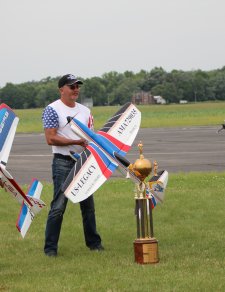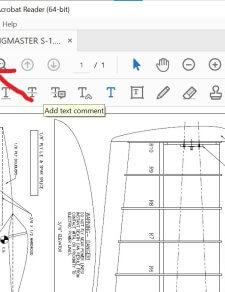History of the Thundergazer

2018 Issue 6
May 17, 2019
2019 Issue 1
August 29, 2019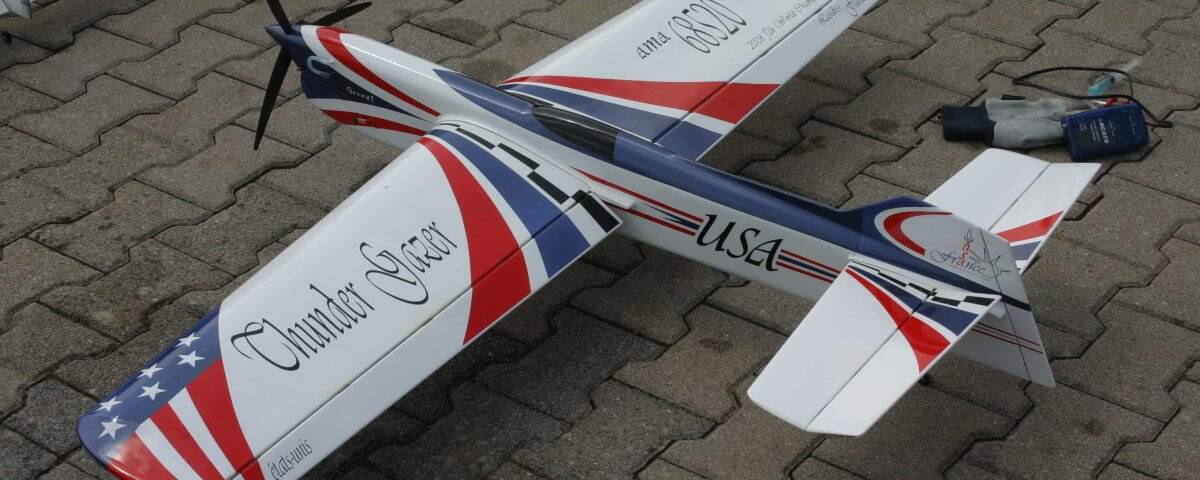
Donating a Champion – the History of the Thundergazer
By David L. Fitzgerald
David Fitzgerald’s “Thundergazer” design has become one of the most – if not the most – competitively dominant control line stunt designs of recent years. In May of 2019 David decided to donate the original Thundergazer airplane to the Robert Shaw Learning Center at the Triple Tree Aerodrome in Woodruff, South Carolina. The following is a copy of David’s letter to the Robert Shaw Learning Center, gifting the airplane to their facility and giving a little of the airplane’s impressive history.
To: Robert Shaw Learning Center, Mr. Harold Bittner
From: David Fitzgerald
Subject: Aircraft donation, ThunderGazer
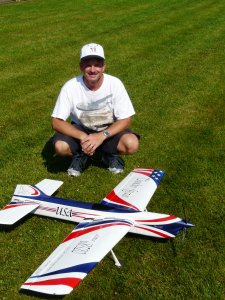 I’ve been competing as a US member of the F2B CL aerobatics team since 1994 and have competed in a total of 10 different world Championships to date. I’ve won the world championships once, in France, 2008. I’ve been second twice, and a third. I’ve also been a part of several F2B 1st place team championships.
I’ve been competing as a US member of the F2B CL aerobatics team since 1994 and have competed in a total of 10 different world Championships to date. I’ve won the world championships once, in France, 2008. I’ve been second twice, and a third. I’ve also been a part of several F2B 1st place team championships.
As part of this grand adventure, I’ve been to France two different times, both in Landres. The first time was 2000, and was not a good experience with the weather. The site is built on top of a hill, with a vertical wall, and surrounded by trees. The wind turbulence can be severe. My plane at the time did not handle the weather very well at all. I needed a better plane for the conditions. I needed a plane that would penetrate wind and turbulence and not be buffeted around by the wind. It needed to be a reasonable weight, be built to disassemble for travel, yet durable. Thus, the idea for the first ThunderGazer was born.
I designed it specifically for the turbulent flying conditions at Landres, France. The wing needed to be able to generate enough lift without stalling, and to be able to carry significant amounts of weight while flying in the rain. Bill Werwage had such a wing design in his Geo/Thunderbolt series. He allowed me to use his airfoil for my project. I decided that a high aspect ratio should do the trick. The wing is 630 square inches in size, fairly small for a competition aerobatics plane. I reduced the size of the flaps to reduce the control loading in maneuvers, but it had to still generate enough lift to maneuver. For the tail I also used a version of what I had developed over many iterations and experiments with my Stargazer design, which was a low aspect ratio/high drag airfoiled tail. It needed a high degree of stability with good tracking. Fairly long tail moment, 25% volume of the wing, and 60/40 split of stab/elevator.
I built the original plane over the winter of 2007, and it first flew on May 30, 2008. It has an Aero Products PA 75, with an Eather #10 carbon fiber tuned pipe, a Kaz Minato carbon fiber 8.25 oz fuel tank, and an Eather 3-blade 13.0” x 4.2” carbon prop. The finish is Sig dope with some automotive toner for added color. I usually fly the plane on 10% nitro fuel.
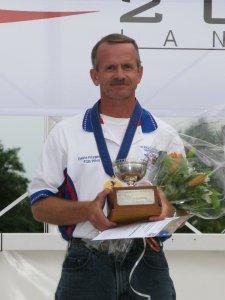 This combination proved highly successful. Its major competitions are:
This combination proved highly successful. Its major competitions are:
- 2008 F2B world championships 1st place, Landres France
- 2009 US Nationals win in CL Precision Aerobatics
- 2010 5th place Gyula Hungary
- 2018 US Nationals win in CL Precision Aerobatics
- Golden State Stunt Championships, Madera CA
- Northwest regionals in Oregon
- Southwest Regionals in Tucson AZ
I had retired the original plane when I built a new ThunderGazer for the 2012 Championships in Sofia, Bulgaria, so it hadn’t flown for several years. I had visited the Triple Tree Joe Nall in 2017, and saw the Robert Shaw Learning Center and Museum for the first time. It features planes that have won the Control Line aerobatics US nationals. I asked Mr. Shaw if he would accept my plane for display in the museum, having a significant competition history, and he graciously accepted. I had one condition, that I was going to fly it one more competition season before donating it to the museum, he agreed. Its last year flying, and a very successful one, was 2018, where it won the US nationals again, and where it received 19 appearance points out of a possible maximum 20. Quite an accomplishment for a 10-year-old model aircraft!
I again visited Triple Tree Aerodrome Joe Nall in May of 2019, where I flew in their Control Line contest, and formally offered the plane, where it was accepted by Mr. Shaw and Pat Harness, for induction into the Learning Center museum.
You see the plane now as it flew its last flight. Derek Barry had the honor of the last flight on May 18th, 2019, before its retirement. It has logged a total of 1,340 flights in its distinguished career.
Dave Fitzgerald

